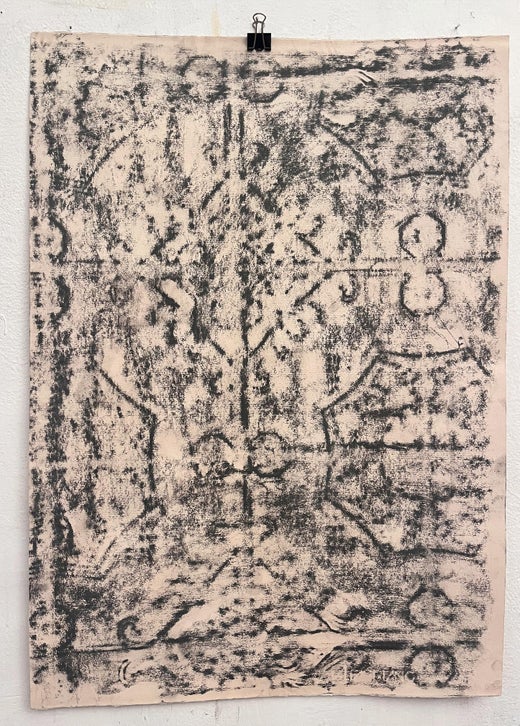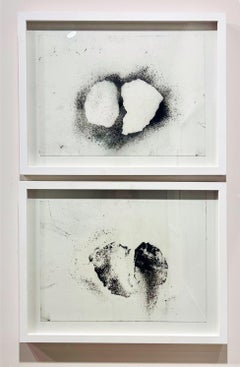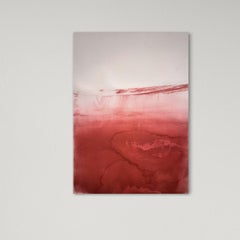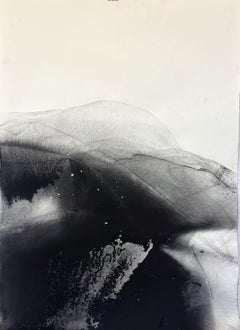Want more images or videos?
Request additional images or videos from the seller
1 of 10
Marilina MarchicaLandscape Black and White - Original Paint - Large Size Made in Italy
$1,734.25List Price
About the Item
- Creator:Marilina Marchica (1984, Italian)
- Dimensions:Height: 29.93 in (76 cm)Width: 22.45 in (57 cm)Depth: 0.79 in (2 cm)
- Medium:
- Movement & Style:
- Period:
- Framing:Framing Options Available
- Condition:
- Gallery Location:Agrigento, IT
- Reference Number:1stDibs: LU1764212013182
Marilina Marchica
Marilina Marchica (Agrigento, 1984) lives and works in Agrigento. She trained at the Universidad Politécnica de Valencia and the Academy of Fine Arts in Bologna, where she graduated in Painting. He has participated in several exhibitions on national and international territory. In addition to the solo shows at the FAM Gallery in Agrigento, the A Sud Arte Contemporanea gallery in Realmonte, Spazio Hus Milano and the site-specific exhibition for the crypt of the Church of Santa Maria del Piliere in Palermo, we remember his participation in the FAM Prize of the Chiaramontane Factories of Agrigento and at the artist's residence in Villa Aurea - Valle dei Templi, curated by the Superintendency of Cultural Heritage of Agrigento. His works have been published in art magazines and volumes including "The New Collectors Book", edited by Basak Malone (New York, 2015). Her painting tells of the relationship between man, nature and time, the landscape, the sign and the trace, through the stripping, reduction and subtraction of figurative elements.
"my landscapes are" boxes "of memories,
day after day they welcome events and individuals who leave their marks and change their boundaries and appearance "
The aesthetics of the "Sign" in Marilina Marchica's pictorial production starts from a research on architecture
the wall as a diaphragm between inside and outside
this takes on a strong symbolic value for the artist, crystallizes collapses and demolitions, freeing them from oblivion and placing them in a universal dimension that alludes to life and its seasons.
This cyclical and dynamic trend, on the other hand, tends to expand in the "Landscapes" to take on an expanded dimension that aligns itself on the geographical horizons, evoked by a vision of reality bordering on abstraction.
About the Seller
4.5
Gold Seller
Premium sellers maintaining a 4.3+ rating and 24-hour response times
Established in 2015
1stDibs seller since 2022
83 sales on 1stDibs
Typical response time: 2 hours
Authenticity Guarantee
In the unlikely event there’s an issue with an item’s authenticity, contact us within 1 year for a full refund. DetailsMoney-Back Guarantee
If your item is not as described, is damaged in transit, or does not arrive, contact us within 7 days for a full refund. Details24-Hour Cancellation
You have a 24-hour grace period in which to reconsider your purchase, with no questions asked.Vetted Professional Sellers
Our world-class sellers must adhere to strict standards for service and quality, maintaining the integrity of our listings.Price-Match Guarantee
If you find that a seller listed the same item for a lower price elsewhere, we’ll match it.Trusted Global Delivery
Our best-in-class carrier network provides specialized shipping options worldwide, including custom delivery.You May Also Like
Untitled (Georgia III)
By Anastasia Pelias
Located in New Orleans, LA
ANASTASIA PELIAS was born in New Orleans, LA to Greek parents. Her artistic practice is rooted in the dual cultural identity of both her native and ancestral roots in New Orleans, LA...
Category
2010s Contemporary Abstract Paintings
Materials
Paper, Charcoal, Ink, Mixed Media
Untitled (Georgia II)
By Anastasia Pelias
Located in New Orleans, LA
ANASTASIA PELIAS was born in New Orleans, LA to Greek parents. Her artistic practice is rooted in the dual cultural identity of both her native and ancestral roots in New Orleans, LA...
Category
21st Century and Contemporary Contemporary Abstract Drawings and Waterco...
Materials
Paper, Charcoal, Pastel, Ink, Mixed Media
When in Rose, pastel pink abstract watercolor painting on archival paper
By Lisa Fellerson
Located in New York, NY
Lisa Fellerson’s paintings provoke an interplay and tension between line, shape, and color. With no preconceived idea in mind, she begins by dripping, scrapping, and gouging acrylic ...
Category
2010s Abstract Expressionist Abstract Drawings and Watercolors
Materials
Watercolor, Archival Paper, Charcoal, Mixed Media
Nuance, pastel pink abstract watercolor painting on archival paper
By Lisa Fellerson
Located in New York, NY
Lisa Fellerson’s paintings provoke an interplay and tension between line, shape, and color. With no preconceived idea in mind, she begins by dripping, scrapping, and gouging acrylic ...
Category
2010s Abstract Expressionist Abstract Drawings and Watercolors
Materials
Charcoal, Mixed Media, Watercolor, Archival Paper
Rosey Combo, pastel pink and grey abstract watercolor painting on archival paper
By Lisa Fellerson
Located in New York, NY
Lisa Fellerson’s paintings provoke an interplay and tension between line, shape, and color. With no preconceived idea in mind, she begins by dripping, scrapping, and gouging acrylic ...
Category
2010s Abstract Expressionist Abstract Drawings and Watercolors
Materials
Charcoal, Mixed Media, Watercolor, Archival Paper
Soft Rock, pastel pink abstract watercolor painting on archival paper
By Lisa Fellerson
Located in New York, NY
Lisa Fellerson’s paintings provoke an interplay and tension between line, shape, and color. With no preconceived idea in mind, she begins by dripping, scrapping, and gouging acrylic ...
Category
2010s Abstract Expressionist Abstract Drawings and Watercolors
Materials
Charcoal, Mixed Media, Watercolor, Archival Paper
Untitled (Modern Black Charcoal & Gray Abstract Still Life Drawing on Paper)
By Ralph Stout
Located in Hudson, NY
18 x 14 inch drawing on 20 x 16 inch Aquarelle Arches Paper
24 x 20 x .5 inches framed
Thin profile black metal frame, 8 ply white mat
Ralph Stout's works on paper reveal a drau...
Category
Early 2000s Abstract Abstract Drawings and Watercolors
Materials
Archival Paper, Charcoal
$600 Sale Price
40% Off
H 24 in W 20 in D 0.5 in
Untitled 1 (Modern Black Charcoal & Gray Abstract Still Life Drawing on Paper)
By Ralph Stout
Located in Hudson, NY
18 x 14 inch drawing on 20 x 16 inch Aquarelle Arches Paper
24 x 20 x .5 inches framed
Thin profile black metal frame, 8 ply white mat
Ralph Stout's works on paper reveal a drau...
Category
2010s Abstract Abstract Drawings and Watercolors
Materials
Archival Paper, Charcoal
$650 Sale Price
35% Off
H 24 in W 20 in D 0.5 in
Bold Graphic Abstract Expressionist Mixed Media Painting Richard Snyder NYC Art
Located in Surfside, FL
Richard Snyder (American, born 1951)
Untitled
Mixed media painting including charcoal and watercolor
Hand signed to lower right
Dimensions: 30.0" W x 22.5" H x 0.1" D
Richard Snyder is particularly known for his large-scale abstract expressionist paintings exhibiting vibrant colors, often applied in an irregular manner with large gestural brushstrokes. He also was an accomplished sculptor and was amongst the downtown New York art-furniture scene spawned in the 1980s by the Soho gallery ‘Art et Industrie’ founded by Rick Kaufmann. Downtown New York, circa 1977-1980 was a hothouse of creative impulses that flew in the face of restrictions and ran headlong toward riotous expression. Punk, hip-hop, graffiti or neo-expressionism,
Kaufmann looked around for new talent that could create a new kind of art furniture. He felt the design of the day was so standardised, and he wanted to give voice to young artists and bring new ideas to market.
After receiving a BFA from the School of the Museum of Fine Arts in Boston, Snyder made his career in the fields of art and design, practicing sculpture, painting, furniture design and fabrication, interior design, cabinetmaking, construction and industrial design. Along with extensive experience in a wide variety of materials and processes, Snyder also possesses a wide range of visual and experiential vocabulary acquired in his many travels through the Americas, Africa, the Middle East and Central and Southeast Asia. Snyder considers his objects to be not just about form, function, color, material and process, but rather to be fantasies with spirit, magic and story. During his seventeen years with the Art et Industrie gallery, Snyder participated in five solo shows and more than twenty group shows, which established him as a major player in the American Art Furniture movement. His pieces have appeared in numerous publications and media around the world; and they are included in numerous private collections worldwide as well as in the permanent collection of The Art Institute of Chicago. Snyder guest-lectures at the Rhode Island School of Design in Providence, the New School in New York, and SUNY Purchase.
He was included in the seminal Magen H Gallery retrospective of Art et Industrie—a New York Movement. Art et Industrie was the first to exhibit Studio Alchemia, Shiro Takahama, and Ron Arad.
The retrospective included artists such as Forrest Myers, Terence Main...
Category
20th Century Abstract Expressionist Abstract Drawings and Watercolors
Materials
Paper, Charcoal, Watercolor, Gouache
Large 80s Vibrant Dynamic Drawing/Painting Memphis Milano Era
By Peter Stevens
Located in Surfside, FL
it is currently unframed and will be sold thus. Similar in style to the 80s work of Elizabeth Murray. A bright, colorful expressive piece signed (labels are not included as it is un...
Category
1980s 85 New Wave Abstract Drawings and Watercolors
Materials
Conté, Charcoal, Gouache, Rag Paper, Graphite
$3,200
H 26 in W 41 in
More From This Seller
View All"Traces" Abstract Contemporary Drawing Made in Italy
By Marilina Marchica
Located in Agrigento, AG
"traces"
charcoal on paper (canson Montval paper 300 gr) two original non-reproducible drawings,
no prints
with wooden frame and protective glass ready to hang size 40x50 each Artwor...
Category
2010s Contemporary Abstract Paintings
Materials
Paper, Charcoal
Red Landscape, Original Drawing on Paper , Made in Italy By Marilina Marchica
By Marilina Marchica
Located in Agrigento, AG
Red Landscape
Original Drawing
Mineral Oxide on Fabriano Paper
50x70 cm
2024
hand-made drawing
one of a kind
not reproducible
CERTIFICATE OF AUTHENTICITY
Framing options available
Category
2010s Contemporary Abstract Paintings
Materials
Paper, Charcoal
Landscape, Original Black Drawing on Paper , Made in Italy By Marilina Marchica
By Marilina Marchica
Located in Agrigento, AG
Landscape BW
Original Drawing
Mineral Oxide on Fabriano Paper
50x70 cm
2024
hand-made drawing
one of a kind
not reproducible
CERTIFICATE OF AUTHENTICITY
Framing options available
Category
2010s Contemporary Abstract Paintings
Materials
Charcoal, Paper
$947 Sale Price
20% Off
Free Shipping
Red Landscape, Original Paint on Paper , Made in Italy By Marilina Marchica
By Marilina Marchica
Located in Agrigento, AG
Red Landscape
Original Drawing
Mineral Oxide on Fabriano Paper
50x70 cm
2024
hand-made drawing
one of a kind
not reproducible
CERTIFICATE OF AUTHENTICITY
Framing options available
Category
2010s Contemporary Abstract Paintings
Materials
Paper, Charcoal
Traces – Contemporary Abstract Black Artwork on Paper by Marilina Marchica
By Marilina Marchica
Located in Agrigento, AG
Traces (2023) is a large-scale original work on paper (75x110 cm) by Italian artist Marilina Marchica, created with pure mineral oxides on 300 gr Canson paper. The deep, atmospheric ...
Category
2010s Contemporary Abstract Paintings
Materials
Paper, Charcoal
Frammenti – Original Abstract Landscape Drawing on Fabriano Paper, Made in Italy
By Marilina Marchica
Located in Agrigento, AG
"Frammenti – Original Abstract Landscape Drawing on Fabriano Paper with Mineral Oxide by Marilina Marchica, Italy 2023"
Artwork Overview
Artist: Marilina Marchica
Title: Frammenti
M...
Category
2010s Contemporary Abstract Drawings and Watercolors
Materials
Paper, Pastel, Pigment
Recently Viewed
View AllMore Ways To Browse
Angel Ortiz
El Greco
Painting By Texas Artist
Rogers Acrylic Painting
Estee Lauder
Minimalist Textured Painting
Robert Mitchell
White Textured Abstract Painting
Abstract Painting Of Flowers
Expressionist Impasto
Metallic Abstract Art
Red Crayon
Art Striped Paintings
Louise Nevelson Creating A Sculpture
Maui Art
Shizico Yi
Abstract Realism Paintings
Bed Painting




